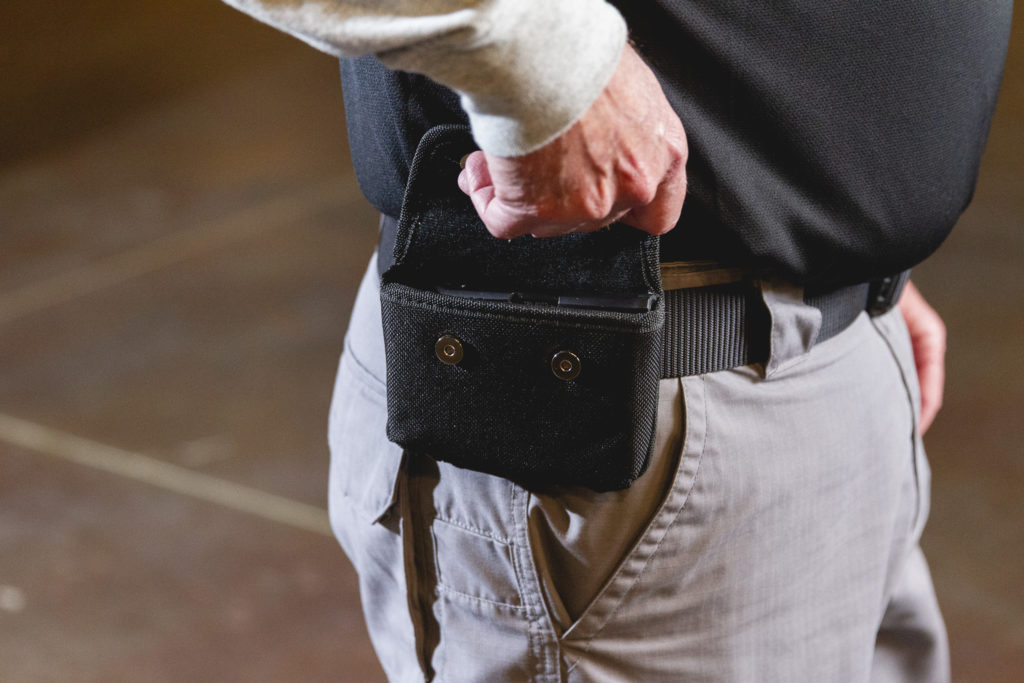Part of the learning process for meeting your concealed carry responsibilities includes deciding on the safest and most effective — and most comfortable — way to carry your handgun. Remember, your Concealed Handgun Carry Permit does not allow open carry, prohibiting you from carrying your handgun so that any part of the gun is visible to the public when it is being carried on or in close proximity to your person. Carrying your gun in a holster does not, in itself, constitute concealed carry.
And contrary to what you may have heard, “printing,” or the imprinting of a handgun behind your clothing, is not considered open carry. Your method of carry should allow your firearm to remain secure and concealed at all times in any body position. So, let’s look at some popular options for carrying a concealed firearm.
On-Body Carry Options
Inside-the-waistband (IWB) and outside-the-waistband (OWB) holsters can be worn in various body positions — small of the back, hip, or appendix areas. These types of carry are the most popular and allow the easiest and quickest direct access to your firearm. Your personal comfort, style of dress, and amount of clothing will most likely dictate preferences here. IWB conceals most of your gun but can be uncomfortable since the handgun is wedged between your pants and body. OWB is the most comfortable, but care must be taken to keep the firearm completely concealed in various body positions.
Shoulder (underarm) holsters may be a good option if you are wearing a jacket. However, the firearm is most often canted in a near horizontal crossdraw position that requires a securing strap or other mechanism to keep the firearm “locked” in place and an impediment to quick access. In addition, an open jacket, from a breeze or from body movement, tends to reveal the firearm.
An ankle holster covered by pants provides secure, reliable cover. However, quick access is very difficult unless your time is most often spent in a sitting position, e.g., as a professional driver. Consider this a good option for a backup gun if needed.
Inside-the-pocket carry can be very effective, so long as you use a quality inside-the-pocket holster that completely covers the trigger and remains, consistently, in your pocket as the firearm is withdrawn. Obviously, gun size is limited using this means of concealment and no other articles should be present in the pocket when you carry this way.
Belly Bands have become an increasingly popular way of securely carrying your firearm in various positions in the waist area, and allow for a variety of gun size options. They are easily covered by a light shirt or blouse; however, they are tight fitting and may contribute to increased sweating in hot conditions.
A thigh holster for women wearing skirts can be a comfortable and effective option for easy, effective concealment depending on the holster design. Stretch elastic, velcro closures and silicone grippers are important considerations since slippage is the biggest disadvantage.
A bra holster under a loose blouse or shirt can provide quick access and increase the element of surprise. However, because the firearm is pointed sideways, care must be taken when withdrawing it under stressful conditions to avoid self injury.
Off-Body Carry Options
Carrying off the body usually provides a less effective means of carrying a firearm, especially if you are prone to misplace or leave your gun. However, if you feel more comfortable carrying this way, or if you are unable for whatever reason to carry on your body, here are some reasonable options.
A special purpose handbag or purse can provide easy, direct access to your firearm. A dedicated pocket or compartment fitted with its own holster is required so that the firearm can be quickly presented without obstruction. If necessary, the firearm can be discharged through the fabric of the purse if you don’t have time to withdraw it.
A briefcase, day planner, over-the-shoulder bag or backpack can, similarly, provide a proper mode of total concealment so long as there is a dedicated pouch or compartment where the firearm can be withdrawn unobstructed. Reinforced handles, straps or tethers are important features in the event someone tries to grab the device or to prevent misplacement.
A fanny pack, simulated mobile phone case or medical pouch can be fastened to your body with a belt to provide added “hidden-in-plain-view” options. Quick access may be somewhat compromised, but waist-level access remains secure without fear of loss or theft.
Conclusion
No matter your chosen means of concealed carry, you must practice again and again to become proficient in drawing your firearm from concealment. Practice in varying conditions and with a variety of attire so you are not required to do so for the first time under extreme stress and immediate necessity. You dry fire your gun to build muscle memory and reinforce proper handling and aiming technique; the same benefit applies when it comes to practicing presenting your gun from concealment.

